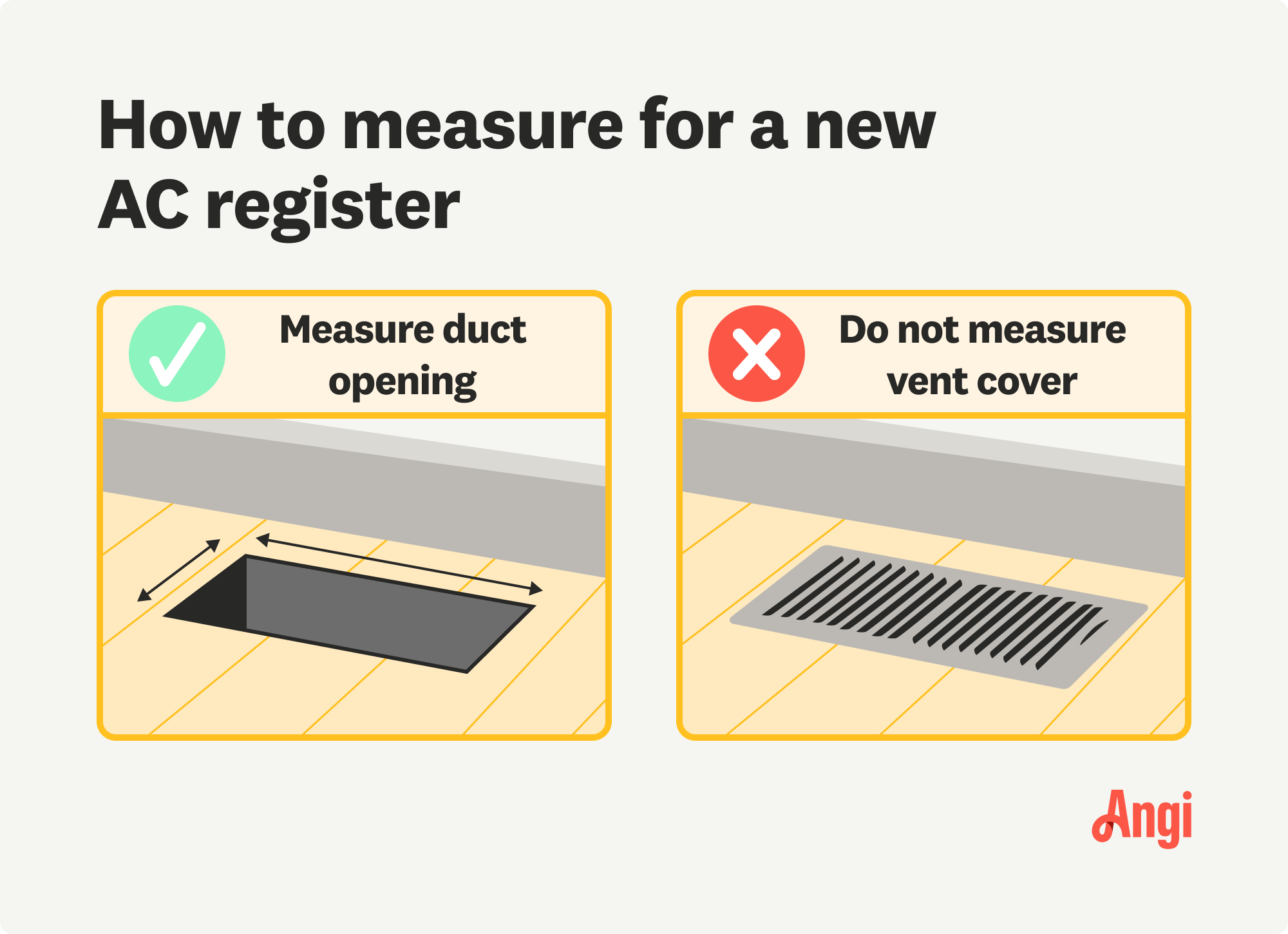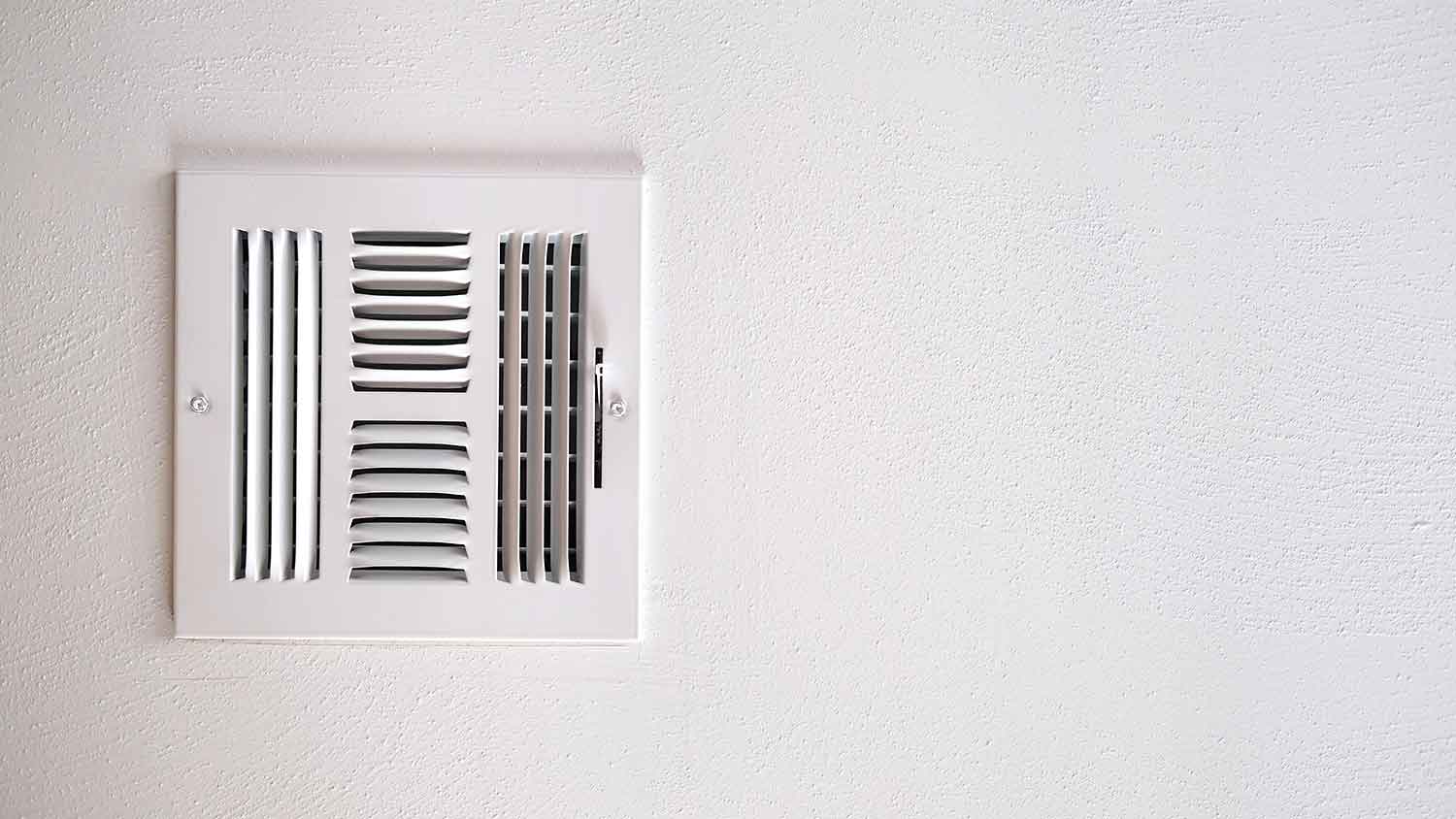
What you’ll pay in Columbus, OH, for furnace repairs depends on many factors. Here’s a breakdown of what can go wrong and the cost to fix those issues.
Controlling your home’s airflow just got easier


AC registers are the visible covers of your vents that allow air to exit the ductwork. They’re defined by their damper component, which enables airflow control.
Grills and diffusers are other common vent covers, but neither one has a damper.
Improper AC register size and placement can cause uneven cooling and energy waste.
Standard AC registers cost $12 to $22 apiece on average.
There’s more to your HVAC system than meets the eye, and that statement couldn’t be any truer when it comes to the AC register. Your registers may just seem like decorative grates on your floor or ceiling, but they play an important role in keeping you at the optimal temperature 24/7. So, what is an AC register, and how does it work to maintain your perfect indoor environment?
An AC register, also known simply as a register, is a vital part of your home's HVAC system. The term refers to the visible cover of your vent that allows conditioned air to enter a room. AC registers consist of a metal grille with slatted openings and a damper mechanism that allows you to control the airflow.
The damper is a crucial component of registers. By adjusting the damper, you can increase or decrease airflow and regulate the temperature and air distribution throughout your home. The addition of a damper is where other similar HVAC vent covers differ from AC registers.

While both registers and grilles feature slatted openings for airflow, they serve distinct purposes within the HVAC system. Grilles primarily act as protective covers for duct openings, preventing debris and foreign objects from entering the ductwork. A grille does not come equipped with a damper like a register does.
Registers and diffusers are similar, featuring slatted openings for airflow distribution. However, they look slightly different and perform different functions within the HVAC system. Registers have slats that face one direction to regulate airflow and serve as outlets for conditioned air. Diffusers have slats facing multiple directions, and they aim to disperse airflow more evenly throughout a room, promoting optimal air circulation and comfort.
Although the terms "register" and "vent" are often used interchangeably when discussing air conditioning basics, they refer to different components of the HVAC system. A register is a visible outlet for conditioned air, and it has a damper that allows airflow control. A vent, on the other hand, refers to the internal portion of the opening that allows air to enter or exit a room. In other words, a grille or register is placed over a vent opening.
Another commonly confused pair of HVAC components is the floor return and register. These are both components of the HVAC system, but they serve different functions. A floor return air vent is an intake vent that draws air into the duct system for reconditioning. In contrast, a register is an outlet for conditioned air, often located on walls, floors, or ceilings.
The size and placement of AC registers play a crucial role in ensuring efficient HVAC performance and optimal comfort levels within your home.
The ideal size of a register depends on the following:
The size of the room
Your airflow requirements
The HVAC system’s capacity
Registers that are too small may restrict airflow, leading to uneven heating or cooling, while oversized registers can result in wasted energy and reduced efficiency.

If you already have a hole in your floor where an old register used to be, measure that hole to determine what size register you need. Do not measure the register itself, as register sizes are determined by the bottom part of the register that actually fits into the duct (not the faceplate). Reach out to a pro if you think your measurements are off. To get a good idea, many standard (aka non-oversized) registers come in the following sizes:
4x10
4x12
6x10
6x12
Similarly, proper placement of registers is essential for achieving uniform temperature distribution throughout your home. Registers should be strategically positioned in areas where airflow is needed most, such as near windows, doors, or high-traffic areas. Additionally, registers should be placed away from obstructions such as furniture or curtains, which can block airflow.
A poorly placed AC register can cause several issues. These include uneven heating or cooling, reduced energy efficiency, and increased wear and tear on the HVAC system. In extreme cases, improper register placement can lead to system malfunctions or failures.

The number of AC registers you need depends on the size and layout of your home, the capacity of your HVAC system, and your desired level of comfort. Larger rooms or areas with high ceilings may need multiple registers to ensure proper airflow and temperature control. Reach out to an HVAC technician if you don’t know what your home needs. They can help determine the optimal number and placement of registers.
The cost of AC registers depends on factors such as the material, size, and brand. Standard metal registers are more affordable, with prices ranging from $12 to $22 per register. However, custom or decorative registers made from high-quality materials such as brass or cast iron may cost significantly more—up to $200 per register.
Proper maintenance of your AC registers is essential for optimal HVAC performance and indoor air quality. Regularly cleaning your registers helps prevent the buildup of dust, dirt, and allergens, which can decrease airflow and reduce your system’s efficiency.
To clean AC registers, remove them from the wall or floor and vacuum or wipe away any debris. Then, place the register and hardware in a bucket of warm, soapy water. Let them sit for roughly half an hour, completely dry them, and put them back on your vents.
If you're unsure about how to maintain or replace your AC registers, don't hesitate to contact a local air conditioner installer for professional assistance.
Installing a new register is a simple and straightforward project that shouldn’t take more than a few minutes.
Registers can be secured using a spring clip or screw. If you see screws in the face of your register, unscrew these and pull it out. Otherwise, grab on the edges of the register and pull it straight out of the wall.
To install a new register with a spring clip, place one side of the register into the wall, then use one hand to tuck the other clip into the gap while pushing it in place with the other.
If your register has screws, push it into the wall and hold it in place with one hand while using the other to screw it into the wall.
From average costs to expert advice, get all the answers you need to get your job done.

What you’ll pay in Columbus, OH, for furnace repairs depends on many factors. Here’s a breakdown of what can go wrong and the cost to fix those issues.

A mini-split allows for zoned cooling, helpful for cooling spaces like garages. Learn the cost to install a mini-split unit in a garage with this guide.

Curious about how much it will cost to add a return air vent? Our guide will help you discover the cost factors and ways to save on this project.

While costly to install, heat pumps are an efficient and eco-friendly way to heat and cool your home, no matter the season.

If your furnace is making loud noises, it could be the first sign something is failing. This guide will go over some of your furnace’s most noisy issues.

Need to purchase a new gas furnace but aren’t sure which type is right for your home and needs? Taking a little bit of time to research furnaces to see which option is right for you can save you money over time. Here’s a look at five furnace types.